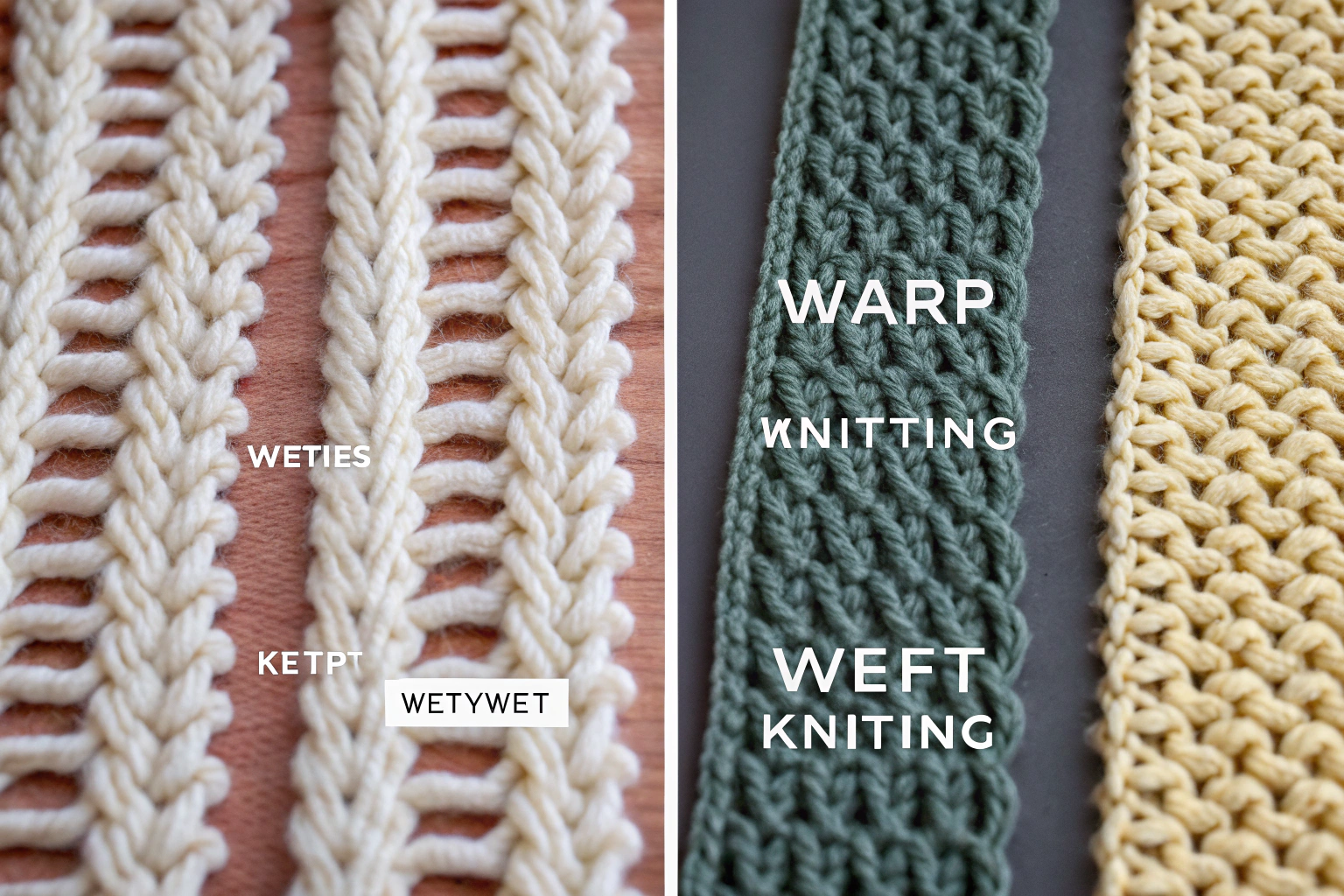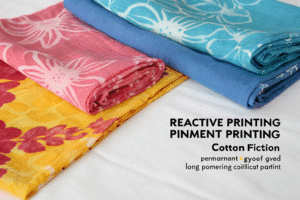If you're sourcing fabrics for your next fashion line, you've likely encountered the terms "warp knit" and "weft knit." Understanding this fundamental difference is not just textile theory—it's crucial for making informed decisions that affect the drape, durability, and cost of your final product. Choosing the wrong type can lead to disappointing performance and unhappy customers.
Simply put, warp knitting and weft knitting are two distinct methods of creating knitted fabrics, defined by the direction the yarns are looped together. Warp knitting involves multiple yarns looping vertically along the fabric's length, while weft knitting uses a single yarn that loops horizontally across the fabric's width. This core difference in construction dictates everything from the fabric's stretch and stability to its common applications in apparel and home textiles.
As a fabric supplier with over two decades in China's textile hub, Keqiao, we help brands navigate these choices daily. This guide will break down these two knitting types in plain English, so you can confidently select the perfect fabric for your project.
How does the basic construction of warp and weft knit differ?
The most basic way to tell these fabrics apart is by their construction. Imagine looking at the back of a fabric under a microscope. What you see reveals the manufacturing process and hints at the fabric's properties.
Warp knit fabrics are made on complex machines with multiple yarn beams. Each needle on the machine is fed by its own individual yarn. These yarns form loops in a vertical direction, parallel to the fabric's selvage (the finished edge). This creates a structure that looks like rows of interconnected "V"s running lengthwise. Because the yarns are interlooped diagonally, the resulting fabric is inherently more stable and less prone to runs. Common examples include tricot, used in lingerie and linings, and raschel knit, used in technical sports apparel and lace.
Weft knit fabrics, on the other hand, are made on circular or flat-bed knitting machines. They use a single continuous yarn that is fed back and forth (or around in a circle) across the width of the fabric. The yarn loops horizontally, from one side to the other, interlocking with the row of loops above and below it. This is the same method you would use if you were knitting a scarf by hand. The classic example is jersey knit, the soft, flexible fabric used in most T-shirts. Other types include rib knit (great for cuffs and collars) and interlock (a thicker, double-faced jersey).
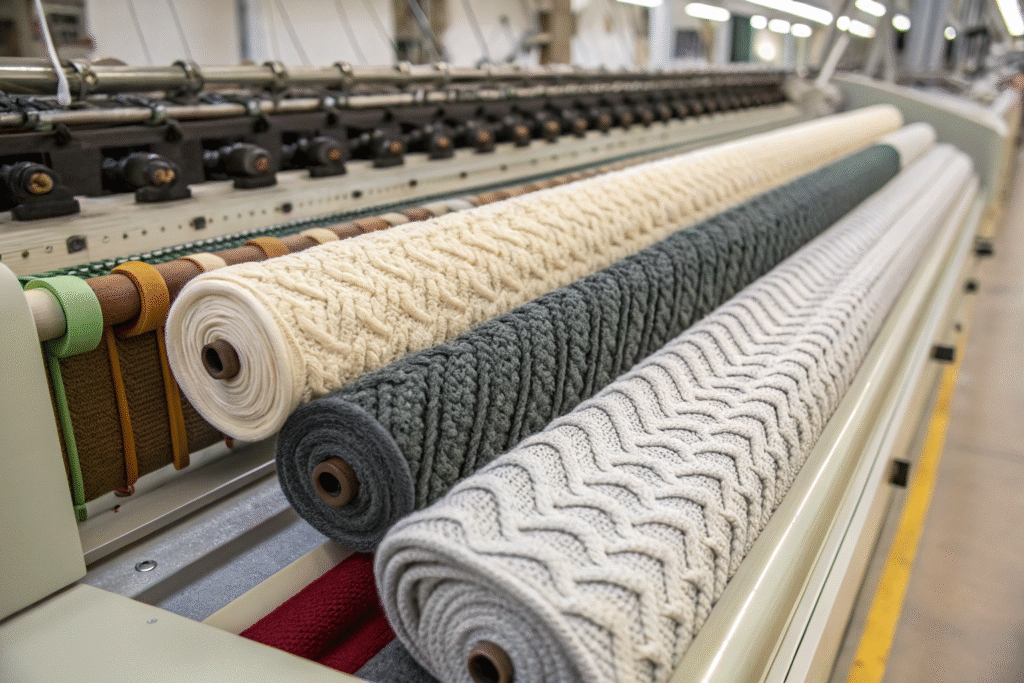
Which knitting method offers greater dimensional stability?
Dimensional stability refers to a fabric's ability to maintain its original size and shape after washing and wearing. This is a critical factor for garment quality control. Warp knit fabrics generally have superior dimensional stability compared to weft knits. The interlooping of multiple yarns along the length creates a firmer, less elastic structure that is less likely to shrink or stretch out of shape over time. This makes warp knits like tricot ideal for applications where consistent shape is vital, such as in uniform shirts, activewear, and linings.
Weft knits, by their nature, are more elastic. The horizontal looping of a single yarn allows the fabric to stretch easily in both the width and length. While this provides comfort and ease of movement, it also means weft knits are more susceptible to shrinking and losing their shape if not cared for properly. A common issue with a basic jersey T-shirt is that it can become wider and shorter after multiple washes. However, this stretch is often desirable for comfort-fit garments.
| Feature | Warp Knit | Weft Knit |
|---|---|---|
| Dimensional Stability | High; resistant to shrinking and stretching | Lower; more prone to shrinkage and distortion |
| Common Uses | Linings, lingerie, athletic apparel, technical fabrics | T-shirts, sweaters, hoodies, casual wear |
| Typical Yarn Path | Multiple yarns moving vertically (warp direction) | Single yarn moving horizontally (weft direction) |
What are the typical applications in fashion and sportswear?
The different properties of warp and weft knits make them suitable for specific end-uses. In fashion, weft knits are the undisputed king of casual comfort. The soft handfeel and excellent drape of jersey knit make it perfect for T-shirts, dresses, and loungewear. Rib knit's excellent crosswise stretch makes it the standard for form-fitting cuffs, collars, and waistbands. The popularity of comfortable, stretchy casual wear has cemented the dominance of weft knits in everyday fashion.
Warp knits find their strength in applications where stability, durability, and a smooth surface are needed. You find them in the linings of suits and jackets, where a slick, stable fabric is essential. In lingerie, warp knits like tricot provide a smooth, run-resistant feel against the skin. The sportswear industry heavily relies on advanced warp knitting technologies, particularly raschel machines, to produce complex technical textiles like engineered mesh for shoe uppers, compression garments, and fabrics with integrated ventilation panels. These fabrics can be engineered for specific moisture-wicking and breathability performance needs.
How does the production process affect cost and lead time?
The machinery and speed of production differ significantly between warp and weft knitting, which directly impacts cost and manufacturing efficiency. Understanding this helps in planning your sourcing and production calendar.
Weft knitting is generally a faster and more versatile process. Circular knitting machines can produce large tubes of jersey fabric at very high speeds, making it an extremely cost-effective method for producing high volumes of fabric. This efficiency is a key reason why basic cotton jersey is one of the most affordable and widely available fabrics globally. The ability to produce small batches quickly on flat-bed machines also makes weft knitting ideal for sampling and smaller production runs.
Warp knitting requires more specialized and expensive machinery. The setup is more complex, as each needle must be threaded with its own yarn. While the machines themselves operate at high speeds, the initial setup time and cost are higher. This often makes warp knit fabrics more expensive on a per-meter basis. However, the production process is highly consistent and efficient for large orders once running. At our facility in Keqiao, we leverage our partnerships with local warp knitting specialists to offer competitive pricing and lead times, balancing the inherent costs of the technology.
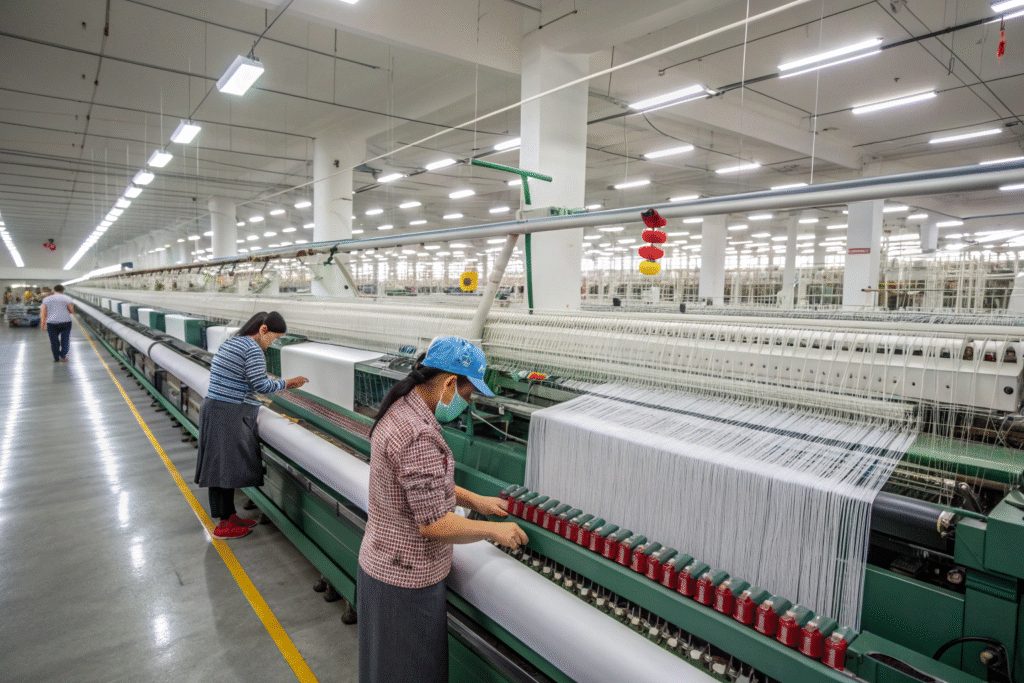
Why is weft knitting often faster for sampling?
Speed to market is critical in today's fast-fashion environment. The sampling process is where weft knitting truly shines. Flat-bed weft knitting machines are highly adaptable. They can be programmed quickly to produce a small swatch or a whole garment panel with a new design, stitch, or pattern. This allows designers to iterate rapidly, testing different ideas without committing to a large and expensive production run. This agility is invaluable for brands that need to react quickly to trends.
In contrast, creating a sample for a new warp knit fabric often requires setting up a full or partial warp beam, which is a time-consuming process involving thousands of yarns. This makes sampling for warp knits more time-intensive and costly. Therefore, warp knit development is typically reserved for established, high-volume products or when the specific performance properties are essential from the outset. For brands looking to innovate quickly with new knit textures, weft knitting provides a much more flexible pathway from concept to sample.
How do MOQs compare between the two methods?
Minimum Order Quantities (MOQs) are a practical concern for every buyer. Generally, weft knitting offers much lower MOQs. This is especially true for fabrics produced on flat-bed machines, which are perfect for producing hundreds or a few thousand meters of fabric. This low barrier to entry makes weft knits accessible to small brands, startups, and for producing limited-edition collections.
Warp knitting operations, due to the high cost of machine setup, typically require significantly higher MOQs to be economically viable. Factories need to spread the setup cost over a larger quantity of fabric. This means that sourcing custom warp knit fabrics often involves commitments of tens of thousands of meters. However, for standard, off-the-shelf warp knits like common linings, the MOQs can be lower due to continuous production runs. Our role as an integrated supplier is to help clients navigate these choices, sometimes offering stock options or consolidating orders to meet MOQ requirements efficiently.
What are the key differences in fabric performance and care?
The structural differences between warp and weft knits lead to distinct behaviors in terms of durability, stretch, and maintenance. These performance characteristics are key selection criteria.
Warp knits are known for their durability and resistance to runs. Because each loop is locked by the adjacent yarns, if one yarn breaks, the run is typically contained and will not unravel the entire fabric. They also tend to be smoother and less porous, giving them better wind resistance. However, they generally have less stretch across the width (though they can be engineered with spandex for elasticity). From a care perspective, their stability means they are less likely to shrink dramatically in the wash.
Weft knits are prized for their elasticity and softness, but they are more vulnerable to snagging and runs. A single broken thread in a jersey fabric can lead to a "ladder" or run, similar to what happens in nylon stockings. They are also more prone to pilling over time, especially in areas of friction. Care instructions for weft knits often emphasize gentle washing and laying flat to dry to prevent distortion and shrinkage. Always checking the care label on a garment's label is crucial for maintaining its appearance.
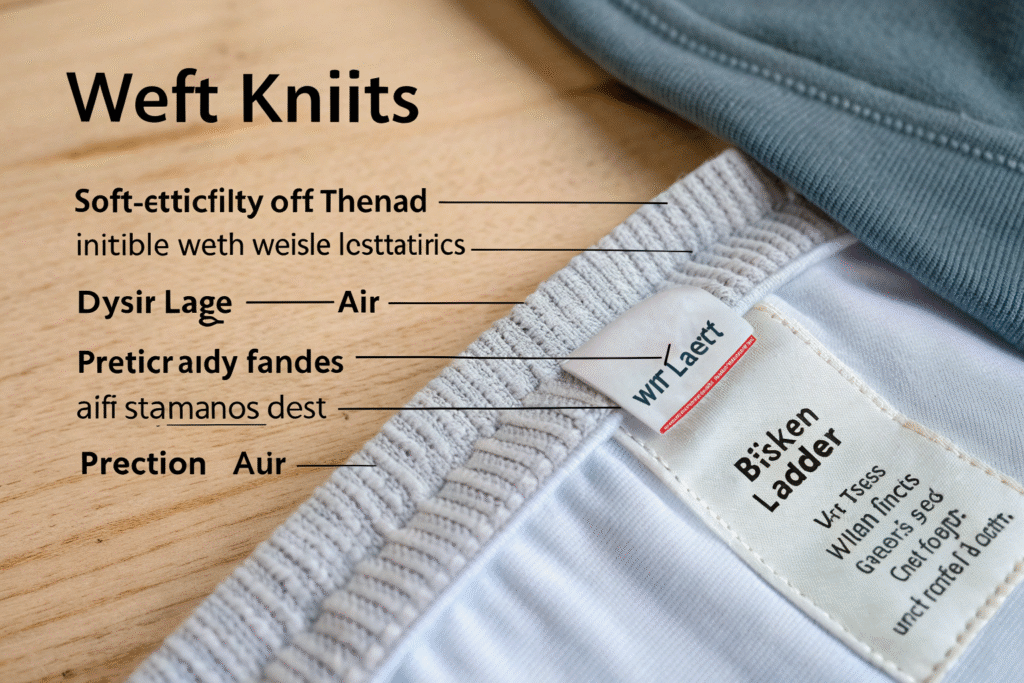
Which type is more resistant to runs and snags?
As mentioned, warp knit fabrics have a clear advantage in snag and run resistance. The interconnected loop structure acts like a safety net. If a yarn is broken, the surrounding loops hold their place, preventing the damage from spreading. This is why warp knits are the preferred choice for products that undergo stress or need to maintain a pristine appearance, such as athletic jerseys, seat upholstery, and hosiery designed for durability.
Weft knits, particularly single jersey, are much more susceptible to runs. The entire structure is dependent on a single yarn looping back on itself. A sharp snag can pull the yarn, unraveling a whole column of loops. This is a well-known limitation of weft knits. However, techniques like using tighter twists or blended yarns can improve snag resistance. For everyday applications like T-shirts, this vulnerability is an accepted trade-off for the comfort and affordability the fabric provides.
How should you care for each knit type to ensure longevity?
Proper care is essential to extend the life of any garment. For warp knit garments, care is relatively straightforward due to their stability. They can often withstand machine washing on gentle cycles. It's still advisable to avoid high heat in dryers to prevent any potential damage to elastic fibers like spandex that may be blended in. Ironing is usually safe at moderate temperatures.
Caring for weft knits requires more attention. To prevent shrinking and stretching, it is best to wash them in cold water on a gentle cycle and avoid wringing them out. Laying them flat to dry is the safest method to maintain their shape, as hanging a heavy, wet weft knit garment (like a sweater) can cause it to stretch permanently. If ironing is needed, using a steam setting is preferable. Following these fabric care guidelines will keep your weft knit garments looking new for longer.
How to choose the right knit for your project: warp or weft?
The decision between warp and weft knit ultimately comes down to the desired performance, aesthetics, and budget of your final product. There is no "better" option, only the right tool for the job.
Choose a weft knit if your priority is comfort, stretch, drape, and cost-effectiveness for medium to high-volume production. It is the ideal choice for T-shirts, sweaters, loungewear, and any product where a soft handfeel and easy movement are paramount. Its flexibility in sampling and lower MOQs also make it perfect for emerging brands and trend-driven items.
Choose a warp knit when you need stability, durability, a smooth surface, and specific technical performance. It is the correct choice for linings, lingerie, uniforms, and advanced sportswear that requires moisture management, compression, or wind resistance. While the initial cost and MOQs may be higher, the performance benefits and longevity can provide greater value for the end-user.
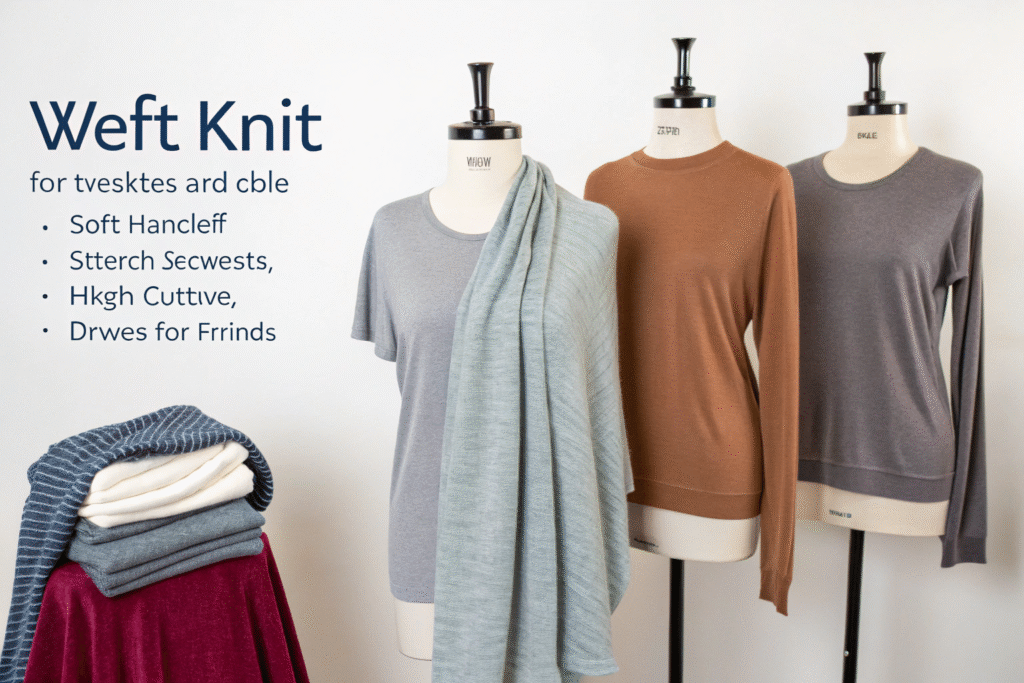
What questions should you ask your fabric supplier?
To make an informed choice, engage in a detailed conversation with your supplier. Don't just ask for price; ask about the fabric's construction. Key questions include: "Can you confirm if this is a warp or weft knit?"; "What is the exact fiber composition and weight (GSM)?"; "Can you provide test reports for pilling, shrinkage, and colorfastness?"; "What are the realistic lead times for sampling and bulk production?"; and "What is the minimum order quantity for a custom color or composition?". A reliable supplier will have this information readily available.
Can warp and weft knits be combined in one fabric?
Absolutely. Innovation in knitting technology has led to the development of advanced machines that can combine warp and weft knitting techniques in a single fabric. This allows engineers to place specific yarns exactly where they are needed for performance. For example, a garment might have a stable warp knit structure in the body for shape retention, with weft knit panels under the arms for enhanced stretch and breathability. These composite knits represent the cutting edge of textile performance but are naturally more complex and expensive to produce.
Conclusion
Understanding the difference between warp knit and weft knit is a fundamental step in successful product development. Warp knit offers stability and durability, while weft knit provides comfort and elasticity. Your choice should be guided by the functional and aesthetic needs of your final garment, as well as your budget and timeline constraints. There is no one-size-fits-all answer, but knowing the strengths of each empowers you to make the best decision.
At Fumao Textiles, we don't just sell fabrics; we provide solutions. Our expertise in both warp and weft knitting technologies, backed by our integrated supply chain in Keqiao, allows us to guide you to the perfect material for your collection. Whether you need the reliable comfort of jersey or the high-performance engineering of a warp knit, we have the experience and capacity to deliver. Ready to bring your next design to life? Contact our Business Director, Elaine, today at elaine@fumaoclothing.com to discuss your specific fabric needs and receive a competitive quotation.

